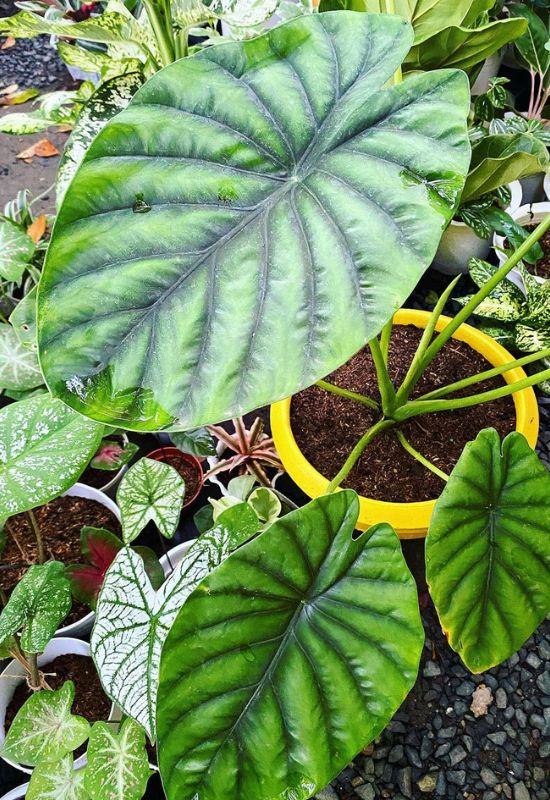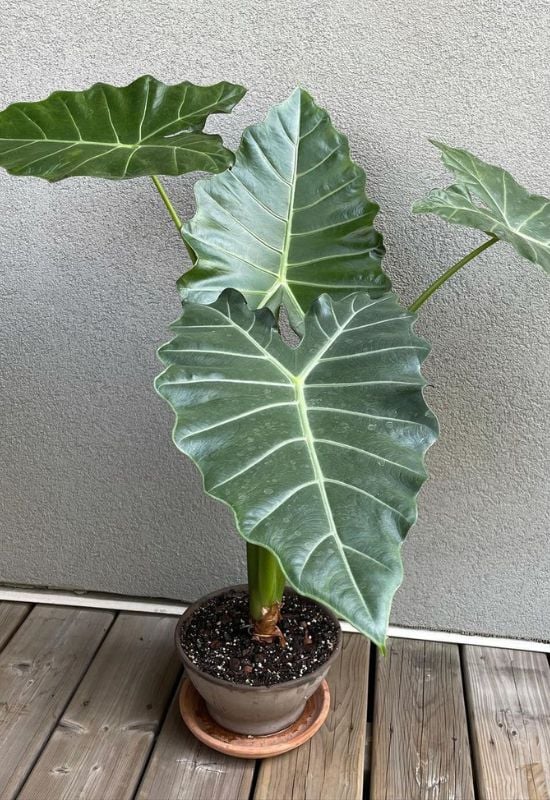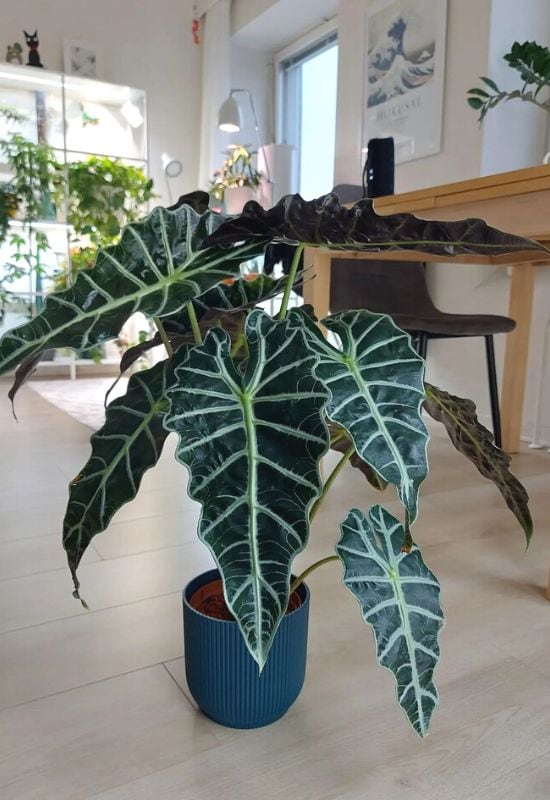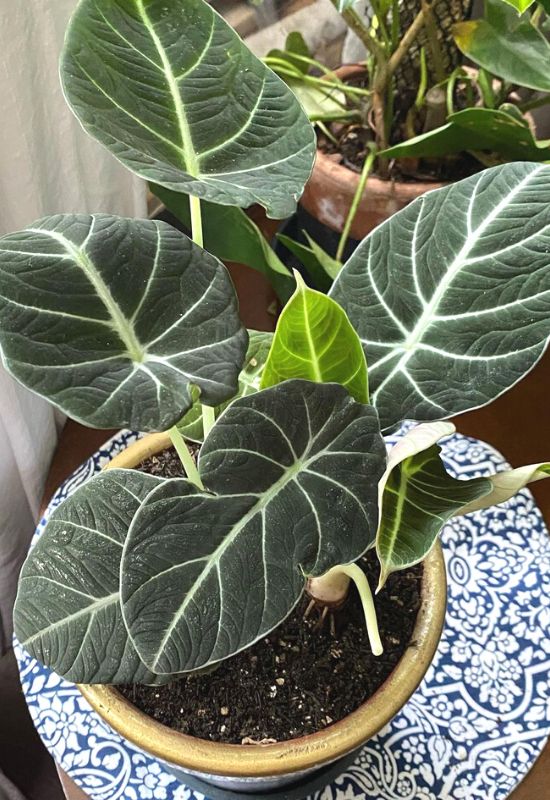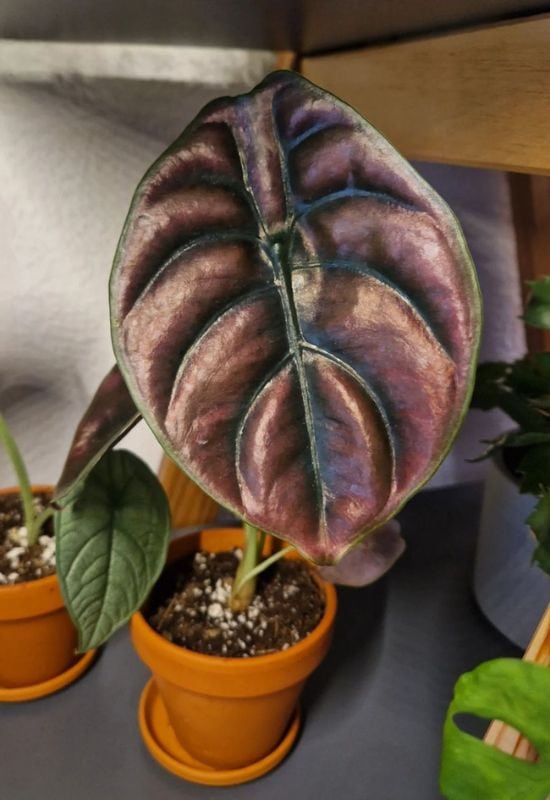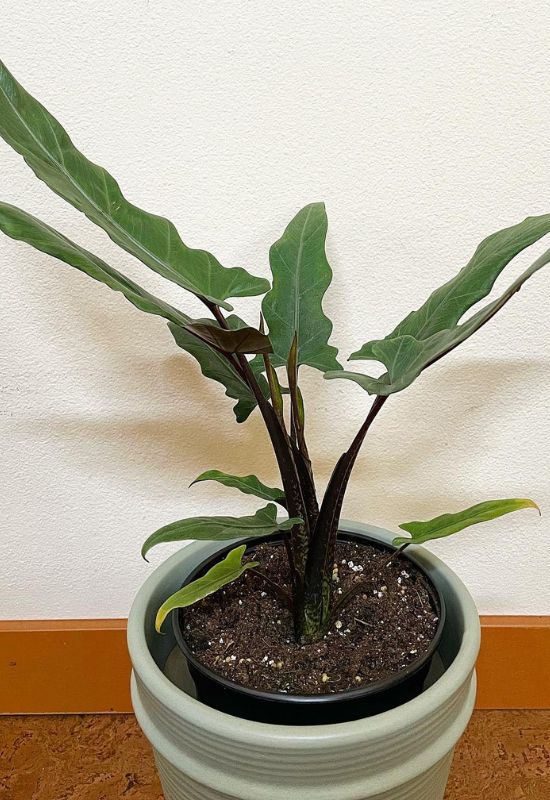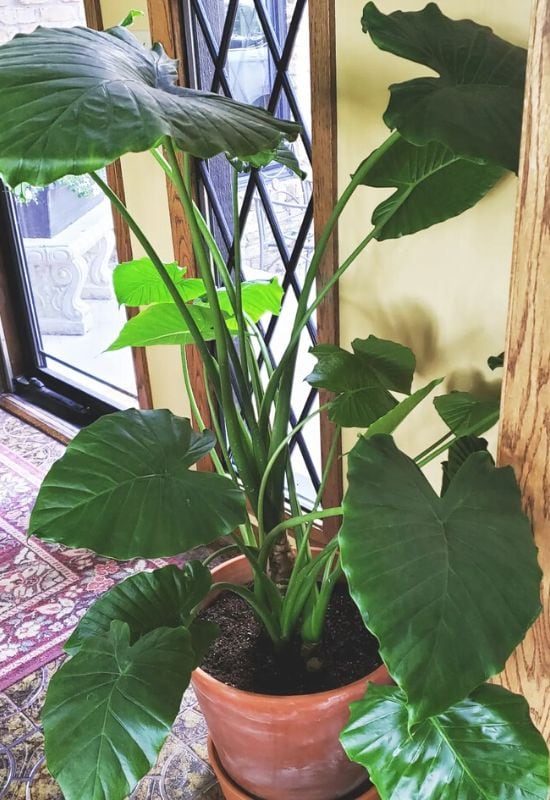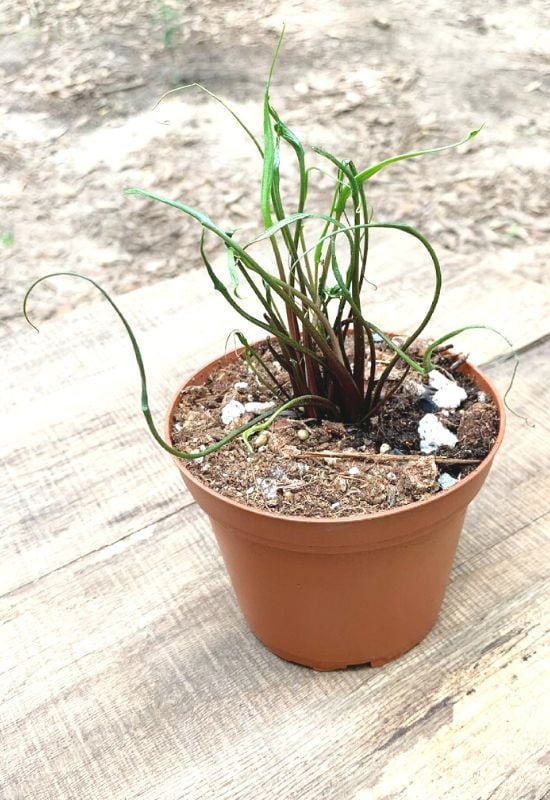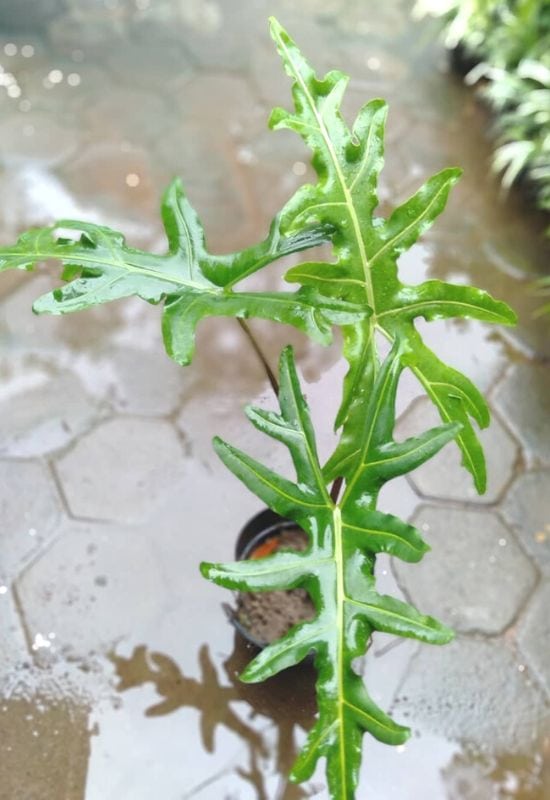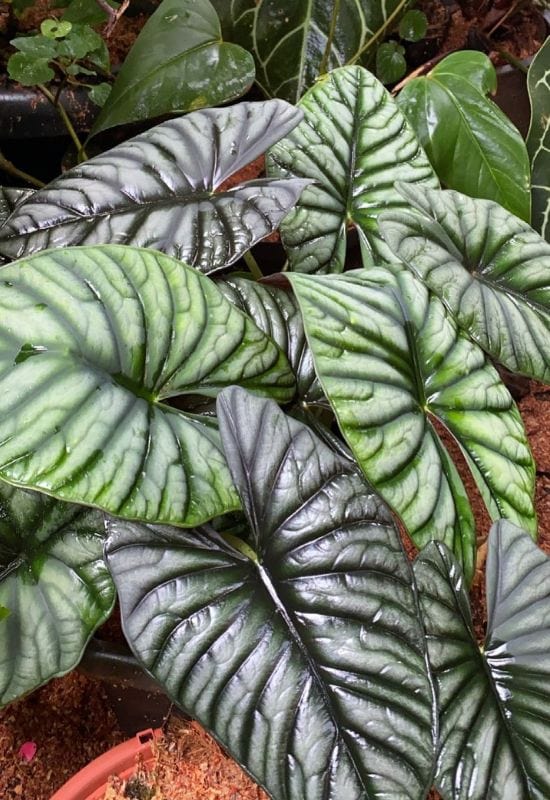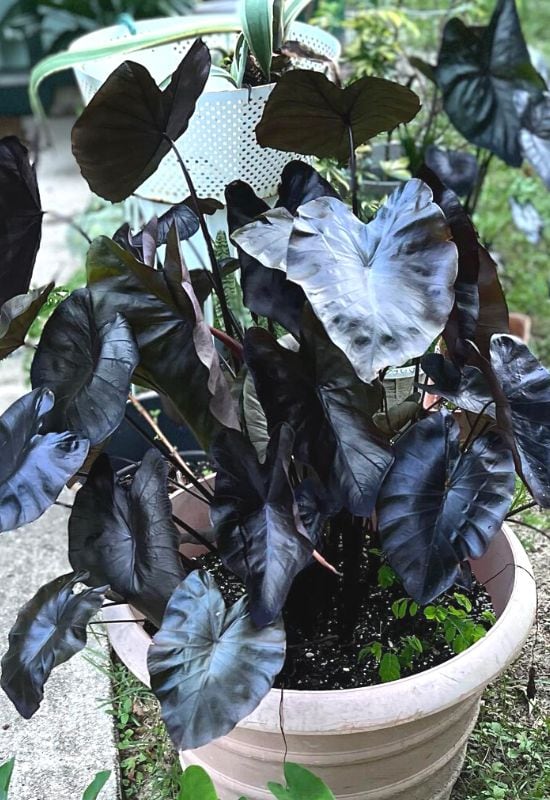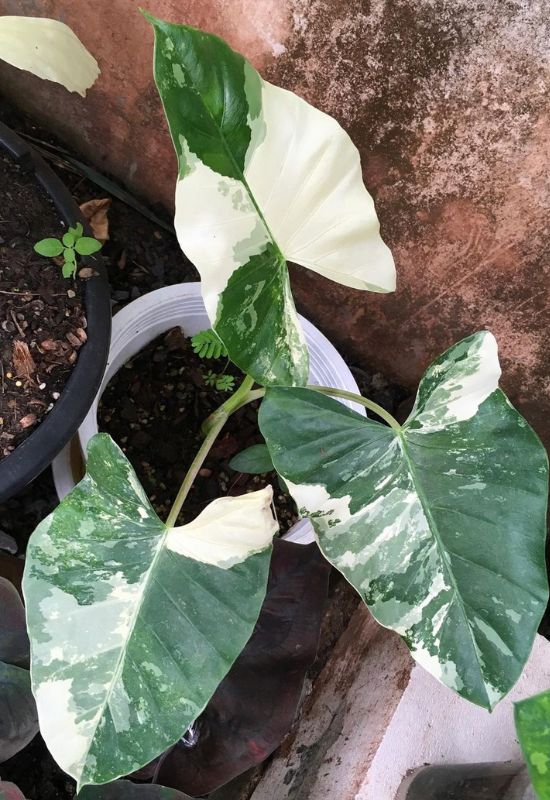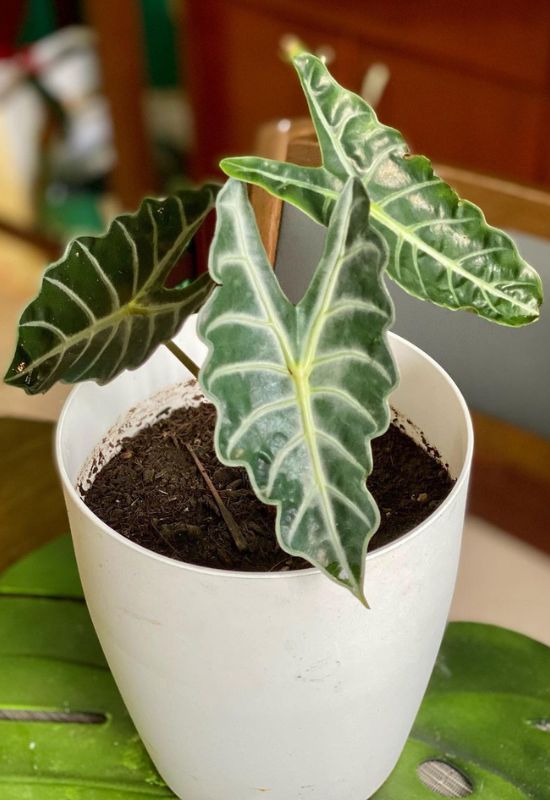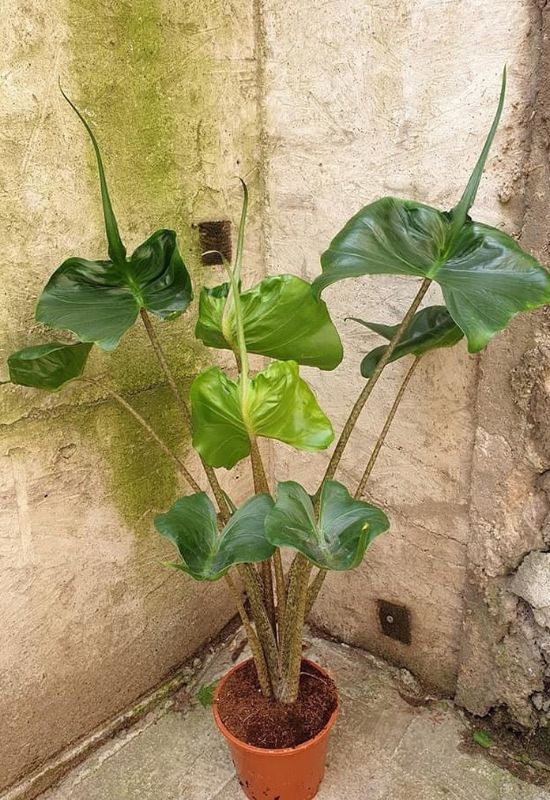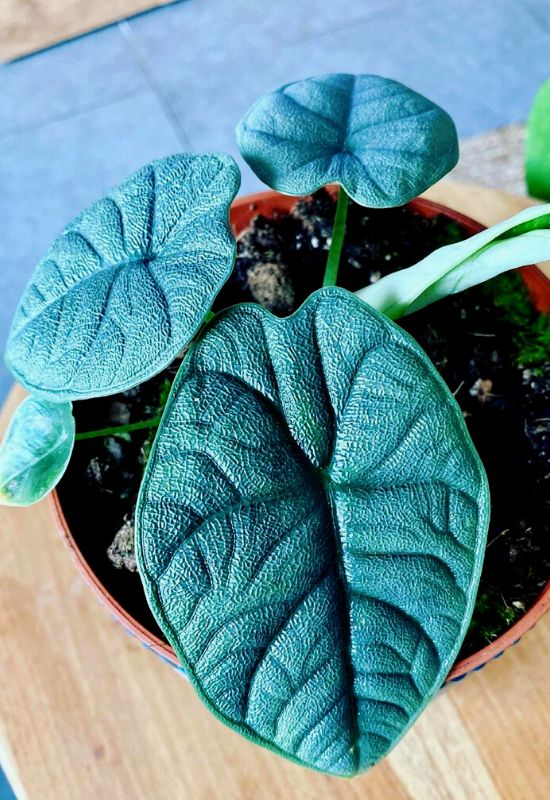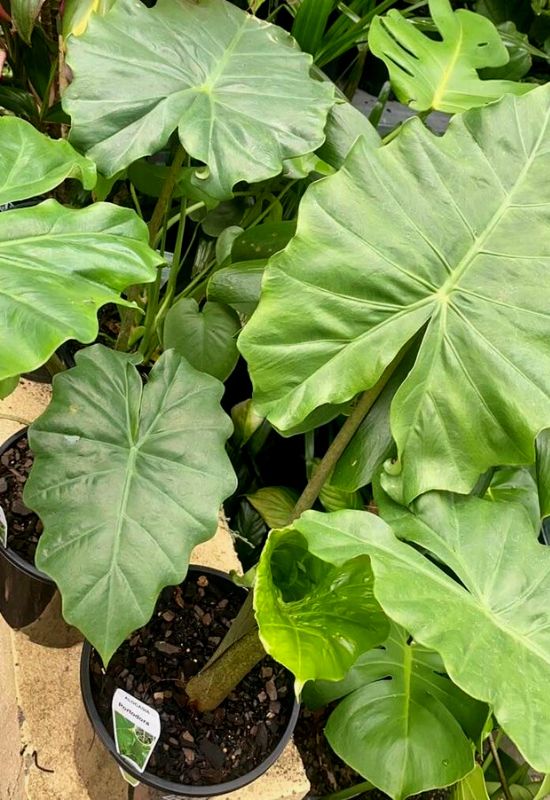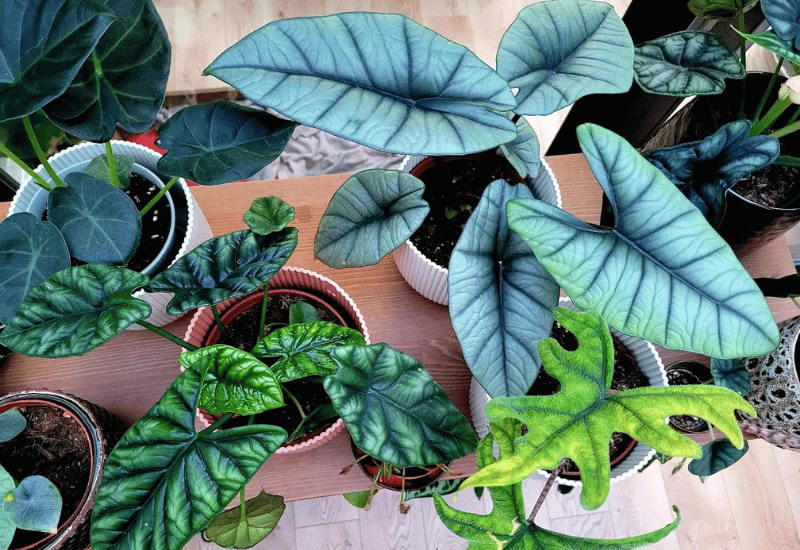
A room lacking a decorative, leafy houseplant often appears empty, dull, and forlorn to me. But whenever I crave a bold and exotic effect, the many Alocasia varieties immediately catch my eye!
Also known as elephant’s ears or giant taro, and native to tropical and subtropical regions of Asia and Australia, Alocasia, a rhizomatous flowering and broad-leaved perennial, holds a special place in our hearts!
Their charm, I believe, is best encapsulated by the saying, “Quality over quantity!” Indeed, with alocasias, you may not get many leaves, but each one is an event, a work of art, akin to a large canvas or a frescoed wall!
Some leaves can even reach an impressive 5 feet long (150 cm)! Coupled with their glossy texture, variegated foliage, and sculptural shapes, they essentially become living statues for your living room, office, or garden!
Unlike many other exotic houseplants, Alocasias willingly bloom indoors, showcasing showy, often large spathes and spadices, reminiscent of peace lilies or anthuriums.
And it’s hard to find an exotic and tropical genus for both gardens and indoor spaces, like Alocasia… With large and small Alocasia varieties, foliage of many colors and shades, they are always incredibly decorative. And with 90 natural species and hundreds of cultivars, your choice for Alocasia is huge.
Given the vast choices, you may need some help picking the right alocasia variety for your indoor décor or garden style. That’s why I’ve handpicked 15 of the most stunning Alocasia types with pictures and care guide to aid you (who cherish these lush beauties as much as I do) in making a more informed decision…
15 Alocasia Varieties To Bring The Tropics To Your Garden And Indoor Spaces
This will be an exotic journey, like finding your way among the lush and sometimes overwhelmingly massive foliage of leafy tropical plants, and here are the protagonists you will meet:
Many of these leafy (and flowering) beauties will do well indoors, and most outdoors as well (in the right conditions), but the first on our list is a real giant from the jungle…
1: ‘Mayan Mask’ Elephant Ears (Alocasia x masquerade ‘Mayan Mask’)
Indeed, the first Alocasia variety on my list, the ‘Mayan Mask’ elephant ears, is a true giant of the genus! This hybrid boasts colossal leaves that can stretch an impressive 5 feet long (150 cm) and 3 feet wide (90 cm)! But its grand size isn’t all that it offers; this exotic-looking perennial has much more to unveil.
The foliage, soaring high from the ground, is held upright by robust, thick petioles, creating a visual reminiscent of tribal shields being hoisted before your eyes.
This imagery is further enriched by the foliage’s incredibly glossy—almost shining—texture that feels leathery to rubbery to touch. The pronounced, clear ribs guide your eyes to the artistically undulated edges, adding to its visual appeal.
But there’s more… While the upper surface of the leaves flaunts a rich green hue, ranging from bright emerald to a deeper tone as it matures, the undersides surprise with a stunning purple shade, carrying an almost metallic allure! Although not a prolific bloomer, when it does blossom, it’s a sight to behold!
The spathes, transitioning from green to white, extend about 10 inches in length, eventually folding into a hood shape to reveal a thick, soft ivory spadix of equal length. And the fragrance is a delightful bonus!
‘Mayan Mask’ elephant ears is an Alocasia variety that promises to deliver an awe-inspiring and overwhelmingly exotic ambiance to a tropical garden with its majestic size and color palette. It’s adaptable to indoor growth as well, although you’d need a spacious room to accommodate its grandeur!
2: ‘Polly’ Amazonian Elephant Ear (Alocasia x amazonica ‘Polly’)
‘Polly’ Amazonian elephant ear is not the largest variety of alocasia, but it is one of the most striking, decorative and dramatic… But its modest size means that it can grow indoors, even in small spaces, and this is why it is a favorite and popular houseplant…
Its main asset are the waxy leaves that display an artistic ivory white pattern that follows the big veins in relief and then it traces the edges of the foliage. All this is set against a very, very dark green background.
It is so deep that it may even appear as black from a distance. Held high up by upright petioles, which can be green or pinkish in shade, they have a great sculptural quality… However, you need to be careful with it…
It is very harmful if ingested and it can irritate your skin and eye at the touch – maybe not an ideal choice if you have pets or children. In case, keep it out of their reach…
But this is a plant that likes to blossom even in enclosed spaces, so you may see the calla lily like spathes in yellow rise from the ground, usually in summer.
‘Polly’ Amazonian elephant ear is by far one of the best varieties to grow indoors, but if you live in a hot country and you are looking for an exotic touch for a tropical garden, it can really add lots to your landscaping.
3: ‘Black Velvet’ Elephant Ear (Alocasia reginula ‘Black Velvet’)
Here is another small alocasia cultuvar, perfect as a houseplant, suggestively called ‘Black Velvet’ elephant ear… And this will give away its sumptuous softness… yes, because the heart shaped leaves are thicker than in other varieties, and they look like they are made of some comfortably warm material, maybe pile fabric…
And the deep green that coats them, on the Sacramento range adds to the luxurious effect of this little plant… But this tonality can darken to almost black, and with a snow white spider like pattern that follows the veins and edges, it is really impossible to ignore.
However, the under pages are different, with shades of rosy pink to purplish and bright pea green veining… The flowers are infrequent and mote common outdoors, but quite beautiful… The long and elegant, vase shaped spathes are cream to soft pink, and the spadix inside is ivory and narrow.
Yet again, compact ‘Black Velvet’ elephant ear is really perfect as a houseplant, but you can grow it in your garden if winters are mild, and it is alsosuitable for a lush and expensive looking green splash in deep shade.
4: ‘Red Secret’ Elephant Ear (Alocasia cuprea ‘Red Secret’)
If you like very sophisticated tonalities you will love ‘Red Secret’ elephant ear! In fact, this cultivar of Alocasia cuprea, a species native of Borneo is really sublime… You will see shades of purple, even very dark, touching notes of burgundy and plum, or paling to rose blushes, but also hints at copper and bronze, depending on the leaves’ age and lighting conditions.
Super glossy to the point of shining, especially if you wipe it regularly, the heart shaped foliage hangs elegantly from the upright petioles… Sometimes, along the veins that are in low relief, forming sinuous patterns, develop a very deep green on the dark basil to pine range – very rare indeed!
Small and suitable for indoor spaces, it has a little downside: it will not bloom, but – in the end – what do you need flowers for when you have such amazing foliage?
Growing ‘Red Secret’ elephant ear on your office desk or living room table is like having a living bronze statue, with amazing color and light effects. It is not a common outdoor variety, but, again, if you can afford it…
5: ‘Purple Sword’ Elephant Ear (Alocasia lauterbachiana ‘Purple Sword’)
If you want sheer elegance in your office or living space, you should definitely have a look at ‘Purple Sword’ elephant ear. Its lean and refined personality is, in fact, really hard to match.
The foliage is wonderfully and regularly undulated at the margins, and lance to spearhead shaped, pointed, upright in the middle and slightly outward looking at the sides, and rising like a ballerina on tips, thanks to its long and straight petioles!
Then, of course we need to talk about its color… Or colors to be correct… Shades of green that range from deep emerald green to hay mix seamlessly on the long and glossy leaves, but the under pages will blush to purplish tonalities, while the upper sides take on copper and bronze hues.
Of all the Alocasia varieties, ‘Purple Sword’ stands out for its delicate presence, not bold as others, but unfortunately, this cultivar will not grace your rooms with blooms.
Ideal for smart looking and bright spaces, ‘Purple Sword’ is the alocasia variety you want to make a statement of sophistication and good taste; for this reason, it is possibly one of the best for office spaces.
6: Night Scented Lily (Alocasia odora)
Coming from southeast Asia, night scented lily is an impressive garden variety of alocasia… Its size and personality are extraordinary to give you that super tropical, lush, rainforest underbrush look!
The leaves are glossy, rubber like in texture, with a fan like pattern of elegant veins, and wavy edges. Each can reach 2 feet in length (60 cm) and 1 foot in width (30), but despite the size, the strong petioles hold this heavy emerald green foliage upright…
However, when new ones come out of the soil from the underground rhizome, they are almost lime green in tonality, fresh and crisp! But you must have noticed something about the name of this species…
And it comes from its blooms! With peach spathes and spadices, they look like calla lilies, and they are very fragrant, especially at night! But this is not the end of its display… The blossoms are followed by bright red, round berries that make a very colorful and bold statement.
Ideal as an accent plant or in a large border in a tropical garden, night scented lily could also be an indoor houseplant, as long as you have a big room where it can grow to its full size. Still, it is more of an outdoor variety….
7: ‘Flying Squid’ Alcoasia (Alocasia plumbae ‘Flying Squid’)
Our genus of exotic rhizomatous perennials is famous all over the world for its big, broad foliage, but there is an exception… ‘Flying Squid’ is, yes, an elephant ear variety, but really not what you might expect!
This little alocasia does not look like her other sisters… The name is the best way to describe it… And, in fact, it looks as if it has no leaves at all, but long and twisting tentacles that rise from the ground… Yes, it looks as if someone had planted an octopus or a squid with its head into the soil!
You may see some “hints at leaves”, because they are folded inti tubes, and they sometimes open a tiny bit, usually at the tips… In fact, it may resemble a succulent, twisty frizzle sizzle (Albucaspiralis)…
The color changes… At the ends, it will show green tonalities, from bright to deep emerald, but the older part of the foliage, towards the base, will flare up to purple shades. This very unusual cultivar, however, will not blossom, and this is the only downsize.
Mainly a houseplant you can keep even on a shelf or in a small space, ‘Flying Squid’ alocasia could also add an original twist to rock gardens of flower beds in Mediterranean or tropical gardens.
8: Porte’s Alocasia (Alocasia portei)
Coming from the Philippines, Porte’s alocasia, a.k.a. Malaysian monster, is named after the French botanist Marius Porte, and it too is very original… Growing into a giant, this exotic species has massive petioles that hold deeply lobed leaves, which are sagittate in overall shape and they can be massive, up to 5 feet long (1.5 meters)!
Nevertheless, this plant manages to keep the them upright, and you will enjoy its glossy and dark, deep green color, but they can be chocolate and mottled on the under pages… The inflorescence is another display of strength like few…
The spathe can be 12 to 16 inches long (30 to 40 cm), brownish green in color, and at first folded into what looks like a bull’s horn… Then, it opens into a lanceolate shape to reveal the streaked spadix inside!
Giving you both amazing texture, a strong personality and an amazing tropical effect, this is one of the most exceptional varieties of elephant ears ever!
Porte’s alocasia is, of course, an amazing asset for a tropical and exotic garden; as an accent plant, it will give you the amazing rainforest and oversized statement that few other plants can achieve. Fortunately, it will keep smaller un a container, so you can grow it indoors as well!
9: ‘Imperialis’ Elephant Ear (Alocasia nebula ‘Imperialis’)
Here is a much loved and popular cultivar of elephant ears, called ‘Imperialis’. Especially appreciated as a decorative houseplant, this alocasia has plump looking foliage which develops a zebra like pattern on the upper pages of the foliage, which follows the veins that lead to the smooth edges…
The exact coloring ranges quitesignificantly according to lighting conditions, maturity of the leaves and even the specimen itself, but this is not a downsize…
On the contrary it will be a nice personal touch this perennial gives you, displaying silver to even whitish shades and stripes from greenish, even aquamarine, to purplish!
The undersides, on the other hand, will be purple, soft and uniform. Compact and small but with an open habit, it is really excellent for indoor spaces, but, like other varieties with these qualities it will not give you blooms.
‘Imperialis’ elephant ears will suit any well lit indoor place, even on a coffee table, thanks to its size. Rarer as an outdoor plant, this alocasia variety is sometimes grown in containers for patios or terraces in hot countries, or during the summer months.
10: ‘Black Magic’ Elephant Ear (Alocasia infernalis ‘Black Magic’)
And we come to the gothic prince of the Alocasia genus: ‘Black Magic’ elephant ear! Yes, you guessed correctly… It is virtually black, even if, as you know, we mean very, very dark and deep purple by this term, in gardening.
It will need the correct lighting to develop the really deep shades it is famous and unique for, otherwise you will see some greenish tonalities appear from under this tenebrous color, especially in young leaves, that will then darken with age.
Smooth edges and roughly heart to arrowhead shaped, the leaves are also extremely glossy, and the light and darkness effectyou get from it are unique! Unlike other very specialized cultivars, ‘Black Magic’ will blossom, and that will be a great surprise!
The hooked spathes are green at the base, but they display amazing stripes of purplish and cream greenish at the back. The ivory whiteness of the inner page matches that of the spadix!
‘Black Magic’ elephant ears is small, but packed with personality, and it is an outstanding indoor variety because its blackness makes it especially sculptural. Having said this, yet again, if you love in a hot country, you can enjoy its dark beauty outdoors as well.
11: White Variegated Elephant Ears (alocasia macrorrhiza albo variegata)
Sometimes called ‘Snow White’, this variety of Alocasia is in direct contrast with ‘Black Magic’… In fact white variegated elephant ears, also called giant taro, offers you a great effect, with wide and showy ivory patches on a bright green background.
There are cases when a whole leaf, and sometimes even the whole plant, is fully white! But this usually has a limited time span, and I suspect that those who claim it have cut the green leaves to cheat us a bit with the pictures.
Still, the glossy and sagittate (arrowhead shaped) leaves with smooth margins and a glossy texture give you a dramatic and very unusual effect and they can grow to a considerable size (up to 2 feet long, or 60 cm), but to achieve the best color effect possible, it needs a lot of light, otherwise the white areas will darken and then they will switch to green…
While it is not a very willing bloomer, it is known to produce blossoms at times, and the spathes and spadices you a final chromatic twist, with their cream to butter yellow shade!
A very striking and dramatic presence in a well lit living room or office, white variegated alocasia will also bring its green and white beauty to flower beds or borders in hot countries that need an exotic touch.
12: Amazonian Elephant Ear (Alocasia x amazonica)
Amazonian elephant ear is a real classic of the Alocasia genus. And in fact, it is also a win er of the prestigious Award of Garden Merit by the Royal Horticultural Society… I am sure you have seen it already, and you will easily recognize it because it looks like tribal shields facing you in a rain forest…
The leaves are long, pointed and sagittate in shape, about 2 feet from top to bottom (60 cm). Leathery and shiny, they have slightly wavy edges, and a clear, contrasting pattern of ivory to cream white veins on a deep, rich green background that darkens as the foliage matures.
One of the most loved varieties of all, and very easy to find, this is also a flowering hybrid… The blooms will usually appear in summer, and they are canna lily like but… The spathe is pale greenish outside and cream white inside, as is the spadix…
Amazonian elephant ear is equally appreciated as for indoor spaces, where it can give you a dramatic, artistic houseplant, or in tropical looking outdoor gardens, where it can recreate an adventure film effect, as if an explorer is faced with a tribe of natives in the tropics.
13: ‘Stingray’ Elephant Ear (Alocasia macrorrhiza ‘Stingray’)
And now you are about to meet one of the most playful varieties of Alocasia, very descriptively called ‘Stingray’ elephant ear! A very much loved indoor variety, its name refers to the shape of the foliage…
In fact, the glossy leaves have been developed by breeders from the sagittate (arrowhead shaped) shape you find in Nature, and they have enhanced both the tip, turning it into a long “tail” and the two lobes at the back, which look like the “wings” of the famous sea creature…
Veins in relief hold this strange figure together, and the color can range from bright mid green. However, some of them may remind you more of being from outer space from the 1979 Alien movie than the flat relative of the shark…
What heightens the effect is that they are held, mainly horizontally, on very thin and long petioles, so they look like they are “swimming in the air”…. It is not a very keen bloomer, but spathes in greenish white may appear in late spring or early summer. And if you want a downsized version of this cultivar, there’s her little sister, ‘Baby Ray’ as well!
Mainly grown as a houseplant, ‘Sting Ray’ elephant ear is a cheerful variety of alocasia for a bit of fun in a room that needs some good humor, fun, and positive energy. Yet again, it will grow outdoors in hot gardens.
14: ‘Melo’ Elephant Ear (Alocasia rugosa ‘Melo’)
The different transformations of this exotic perennial lead us to ‘Melo’ elephant ears, the most popular variety of Alocasia rugosa, a species native to the Sabah state in Malaysia… The binomial name will give away its most distinctive trait and main asset: “rugosa” means “wrinkled”, and this leads us to the amazing texture of the foliage…
Yes, you will see an amazing grooves, very fine and that – well it mat remind you of a brain in cross section… But this is not at all harsh, because the surface is also very soft and velvet like…
A small plant, it will only produce a few of its leaves, which look elliptical in shape (the two back lobes are virtually merged) and they stand horizontal on elegant petioles…
The color can actually range touching quite striking notes, from green to aquamarine, it can also turn to shades of violet purplish, while the under pages are usually cream.
It is not a great bloomer but it can if it gets the right conditions, and the ivory white spathes form a cup at the base, which can have lovely plum colored spots.
‘Melo’ elephant ear is mainly grown as a houseplant, also because its size makes it suitable to small spaces, even a shelf pr a coffee table; its texture brings softness and interest to your indoor life, but, again, if you live in a tropical or subtropical region, your garden would be fine too.
15: ‘Portodora’ Upright Elephant Ear (Alocasia portodora)
And we conclude our journey among varieties of the Alocasia genus with another giant, and a really stunning one… In fact, ‘Portodora’ (also called upright) is the elephant ear you would expect painted in a hieroglyph on the wall of an Egyptian temple…
I say this to give you an idea of what you will get with this big perennial: imagine being on the Nile and having massive fans to refresh the sultry air… Yes, because each leaf can be 5 feet long (1.5 meters) and it is held upright by very big and thick petioles.
What is more, you will see clearly sculpted veins departing from the mid rib like a peacock’s tail, and giving the margins of the foliage a zigzag outline. Glossy and bright to mid green in color, they will rise up far above your head, and – hear, hear – this is a fairly cold hardy variety compared with others!
The flowers, or better inflorescences, are on the same large scale, and they consist of canna lily like cream spathes and spadices, which can blush to russet and brown as they ripen.
‘Portodora’ or upright elephant ear is, of course mainly a garden variety, where it can be an accent plant and create the super exotic feel you are after; but it is so striking that people with large rooms do grow it indoors as well!
Hail the Leafy Queen of the Jungle: The Exotic Beauty Called Alocasia!
Elephant, ear, giant taro, or alocasia, call this tropical perennial as you wish, it is always very striking and exotic, and as you can see, there are many species, for small indoor coffee tables, or for large and hot gardens… You have just met some of the most decorative, and now it is up to you to choose the beauty you love best… I know, it’s hard…

Written By
Amber Noyes
Amber Noyes was born and raised in a suburban California town, San Mateo. She holds a master’s degree in horticulture from the University of California as well as a BS in Biology from the University of San Francisco. With experience working on an organic farm, water conservation research, farmers’ markets, and plant nursery, she understands what makes plants thrive and how we can better understand the connection between microclimate and plant health. When she’s not on the land, Amber loves informing people of new ideas/things related to gardening, especially organic gardening, houseplants, and growing plants in a small space.

